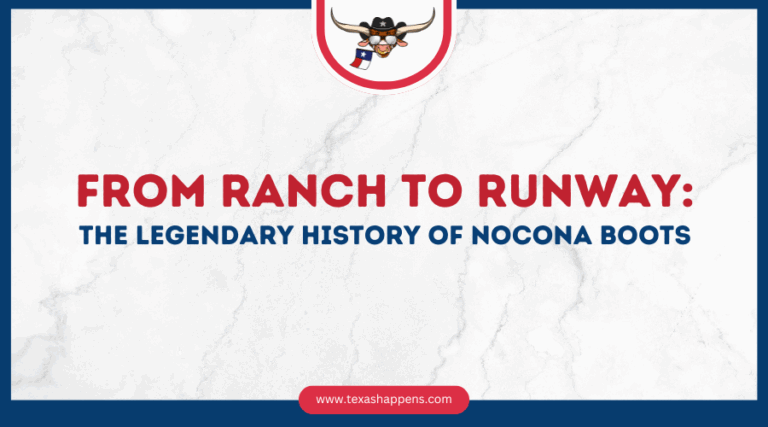Nocona Boots began in 1925 when Enid Justin refused to leave her Texas hometown, borrowing $5,000 to launch her own company after her brothers relocated Justin Boots to Fort Worth. Her vision transformed Nocona into a top boot manufacturer, blending traditional craftsmanship with advancements like high-speed stitching.
After decades of growth, Nocona became part of Justin Industries in 1981, yet their cultural impact continues through fashion runways and films. The story behind these iconic boots stretches far beyond their leather and stitches.
A Family Legacy: Enid Justin’s Bold Vision in 1925
A remarkable story of determination began in 1925 when Enid Justin founded the Nocona Boot Company in the small Texas town bearing its name. When her brothers moved the family’s Justin operation to Fort Worth, she borrowed $5,000 and retained seven employees to preserve her father’s bootmaking legacy in her hometown.
Enid’s entrepreneurial spirit was extraordinary for a woman of her time. Having worked in her father’s shop since age 12, she fearlessly assumed multiple roles—president, founder, and lead salesperson—even driving a Model T Ford to secure sales alongside her sister. Her community leadership kept skilled jobs in Nocona while establishing what would become one of America’s top boot manufacturers.
The discovery of oil in Montague County and nearby fields brought many new customers to the fledgling company, helping secure its early success. Her bold decision demonstrated unwavering loyalty to her community and her father’s craftsmanship traditions.
While Nocona was building its reputation, other Texas bootmakers like M.L. Leddy’s were similarly preserving time-honored techniques that would define authentic Western footwear for generations.
Craftsmanship & Innovation: How Nocona Boots Evolved
View this post on Instagram
While Enid Justin laid the foundation for Nocona’s enduring legacy, the company’s evolution throughout the 20th century reveals a masterful balance between technological advancement and traditional craftsmanship.
You’ll find this balance evident in the 1960s adoption of high-speed stitching, which increased efficiency without sacrificing quality. When oil-field demands emerged, Nocona responded with durable 16-inch lace-up boots designed for harsh conditions. The company’s net sales had impressively reached $19,420,390 by 1980, demonstrating commercial success alongside its commitment to quality.
The company’s expanding facilities—from the 1948 Highway 82 plant to Vernon’s 1977 location—supported these integrations while maintaining handcraft preservation. Much like Conrad Hilton, who recognized opportunity in the Texas oil boom and built his hospitality empire, Nocona seized market opportunities while staying true to its roots.
Despite modernization, Nocona never abandoned its commitment to quality materials and custom-fit designs. Even as operations were consolidated to El Paso in 1999, the company continued blending mechanization with traditional methods, ensuring that each pair of boots carried the authentic craftsmanship that made the brand legendary.
The Golden Era: Expansion and Growth Through the Decades
The post-World War II era ushered in Nocona Boots’ golden age of expansion and unprecedented growth. To meet postwar production demands, the company constructed a new manufacturing plant in 1948 east of Nocona on U.S. Highway 82, followed by retail market expansion through its first Nocona Boot Shop in 1949.
You’d have witnessed remarkable transformation during this period as production soared—reaching $19.4 million in net sales by 1980. The company embraced high-speed automatic stitching in the 1960s and opened an additional facility in Vernon (1977).
This growth paralleled the success of its founder’s family business, as H. J. Justin’s children had transformed their father’s humble boot shop into an industry powerhouse. Enid Justin’s unwavering commitment to quality craftsmanship remained at the heart of operations throughout this expansion period. Their marketing evolved too, with trend-setting campaigns that glamorized boots beyond purely functional footwear.
Despite corporate changes when Justin Industries acquired the company in 1981, Nocona maintained its distinct identity until local manufacturing ended in 1999.
When Dynasties Reunite: The Justin Industries Merger
Corporate reunification brought the Justin bootmaking legacy full circle in 1981 when Justin Industries acquired Nocona Boots—an ironic twist considering Enid Justin had founded Nocona specifically to break away from her family’s company. The sale late in Enid’s life was controversial locally, with disputes over the terms and loss of independence, but it ultimately brought the two legacies back under one roof.
The acquisition strategically positioned Justin Industries to:
-
Become the largest Western boot manufacturer in America
-
Consolidate intertwined family legacies under one umbrella
-
Streamline production and distribution networks
-
Leverage shared heritage for marketing advantage
Manufacturing consolidation ultimately followed, with Nocona’s Nocona-based facility remaining operational until 1999 before operations shifted primarily to El Paso. The factory—about 89,000 square feet with roughly 500 employees at the time of the merger—represented the peak of Nocona’s independent operations.
Though controversial at the time, this reunification preserved collective bootmaking traditions and brand equity.
Beyond the Factory: Nocona’s Cultural Impact on Western Fashion
View this post on Instagram
Beyond traditional boot manufacturing, Nocona’s influence has permeated American culture in four distinct dimensions: as an iconic symbol of Western heritage, a fixture in film and media, a recurring influence in contemporary fashion, and a vehicle for cultural identity expression.
You’ll find Nocona’s rugged individualism represented in Western films where boots symbolize frontier mythology and self-reliance. This cultural significance extends into mainstream media, where the “yeehaw” resurgence has brought Western aesthetics to urban fashion centers.
High-fashion designers now reinterpret these classic boots with materials like mirrored rose-gold leather, making Western style accessible to broader audiences. Like other iconic boot makers, Nocona’s designs feature intricate stitch patterns that blend traditional craftsmanship with contemporary appeal.
Perhaps most saliently, Nocona stands at the intersection of social inclusion movements, helping celebrate diverse American identities—from Black cowboy legacies to contemporary expressions—through the universal language of Western footwear.


